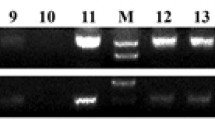Abstract
The responses of aphid parasitoids to completely synthetic and plant-extracted nepetalactone, a component of aphid sex pheromones, were investigated. In wind tunnel tests, Praon volucre and Aphidius ervi responded equally strongly to both plant-extracted and 99% pure synthetic (4aS,7S,7aR)-nepetalactone. In the field, aphid-infested cereal trap plants were used to test the attractiveness of plant-extracted and synthetic (4aS,7S,7aR)-nepetalactone, as well as the synthetic enantiomer (4aR,7R,7aS)-nepetalactone. There was no significant difference in parasitisation levels by Praon spp. between plants baited with the synthetic or with the plant-extracted 7S isomers. However, the 7R isomer was unattractive alone and rendered the synthetic 7S isomer unattractive when combined to form a 50% blend of the two. It is concluded that the response of aphid parasitoids to nepetalactone is influenced more by enantiomeric purity rather than the possible presence of plant-related contaminants associated with plant extraction. The results are compared with data on male aphid responses to the compounds, which indicate that plant-derived contaminants can reduce attractancy, and the implications for the manipulation of parasitoids in the field are discussed.
Similar content being viewed by others
REFERENCES
Dawson, G. W., Griffiths, D. C., Janes, N. F., Mudd, A., Pickett, J. A., Wadhams, L. J., and Woodcock, C. M. 1987. Identification of an aphid sex pheromone. Nature 325:614-616.
Dawson, G. W., Janes, N. F., Mudd, A., Pickett, J. A., Shavin, A. M. Z., Wadhams, L. J., and Williams, D. J. 1989. The aphid sex pheromone. Pure Appl. Chem. 61:555-558.
Dawson, G. W., Pickett, J. A., and Smiley, D. W. 1996. The aphid sex pheromone cyclopentanoids: synthesis and the elucidation of structure and biosynthetic pathways. Bioorg. Med. Chem. 4:351-361.
Dickens, J. C., and Mori, K. 1989. Receptor chirality and behavioral specificity of the boll weevil, Anthonomus grandis Boh. (Coleoptera: Curculionidae), for its pheromone (+)-grandisol. J. Chem. Ecol. 15:517-528.
Du, Y.-J., Poppy, G. M., and Powell, W. 1996. Relative importance of semiochemicals from first and second trophic levels in host foraging behavior of Aphidius ervi. J. Chem. Ecol. 22:1591-1605.
Du, Y.-J., Poppy, G. M., Powell, W., and Wadhams, L. J. 1997. Chemically mediated associative learning in the host foraging behavior of the aphid parasitoid Aphidius ervi (Hymenoptera: Braconidae). J. Insect. Behav. 10:509-522.
Eisenbraun, E. J., Browne, C. E., Irvin-Willis, R. L., McGurk, D. J., Eliel, E. L., and Harris, D. L. 1980. Structure and stereochemistry of 4aβ,7α,7aβ-nepetalactone from Nepeta mussinii and its relationship to the 4aα,7α,7aα-and 4aα,7α,7aβ-nepetalactones from N. cataria. J. Org. Chem. 45:3811-3814.
Glinwood, R. T. 1998. Laboratory and field responses of parasitoids to aphid sex pheromones. PhD thesis. University of Nottingham, U.K.
Glinwood, R. T., Powell, W., and Tripathi, C. P. M. 1998. Increased parasitization of aphids on trap plants alongside vials releasing synthetic aphid sex pheromone and effective range of the pheromone. Biocontrol Sci. Technol. 8:607-614.
Hardie, J., Nottingham, S. F., Powell, W., and Wadhams, L. J. 1991. Synthetic aphid sex pheromone lures female parasitoids. Entomol. Exp. Appl. 61:97-99.
Hardie, J., Isaacs, R., Nazzi, F., Powell, W., Wadhams, L. J., and Woodcock, C. M. 1993. Electroantennogram and olfactometer responses of aphid parasitoids to nepetalactone, a component of aphid sex pheromones, p. 29, in J. M. Rabasse (ed.). Abstracts of Aphidophaga 5—Symposium of the Global IOBC Working Group “Ecology of Aphidophaga.” IOBC, Zurich.
Hardie, J., Peace, L., Pickett, J. A., Smiley, D. W. M., Storer, R. J., and Wadhams, L. J. 1997. Sex pheromone stereochemistry and purity affect field catches of male aphids. J. Chem. Ecol. 23:2547-2554.
Levinson, H. Z., Levinson, A., Ren, Z., and Mori, K. 1990. Comparative olfactory perception of the aggregation pheromones of Sitophilus oryzae (L.), S. zeamais (Motsch.) and S. granarius (L.), as well as the stereoisomers of these pheromones. J. Appl. Entomol. 110:203-213.
Lilley, R., Hardie, J., and Wadhams, L. J. 1994. Field manipulation of Praon populations using semiochemicals. Norw. J. Agric. Sci. Suppl. 16:221-226.
Marsh, D. 1972. Sex pheromone in the aphid Megoura viciae. Nature 238:31-32.
Payne, T. L., Dickens, J. C., and Richerson, J. V. 1984. Insect predator-prey coevolution via enantiomeric specificity in a kairomone-pheromone system. J. Chem. Ecol. 10:487-492.
Pettersson, J. 1970. An aphid sex attractant. I. Biological studies. Entomol. Scand. 1:63-73.
Pettersson, J. 1971. An aphid sex attractant. II. Histological, ethological and comparative studies. Entomol. Scand. 2:81-93.
Phillips, T. W., Nation, J. L., Wilkinson, R. C., Foltz, J. L., Pierce, H. D., Jr. and Oehlschlager, A. C. 1990. Response specificity of Dendroctonus terebrans (Coleoptera: Scolytidae) to enantiomers of its sex pheromone. Ann. Entomol. Soc. Am. 83:251-257.
Pickett, J. A., Wadhams, L. J., Woodcock, C. M., and Hardie, J. 1992. The chemical ecology of aphids. Annu. Rev. Entomol. 37:67-90.
Poppy, G. M., Powell, W., and Pennacchio, F. 1997. Aphid parasitoid responses to semiochemicals—genetic, conditioned or learnt? Entomophaga 42:193-199.
Powell, W., Hardie, J., Hick, A. J., HÖLLER, C., MANN, J., MERRITT, L., NOTTINGHAM, S. F., WADHAMS, L. J., WITTHINRICH, J., and Wright, A. F. 1993. Responses of the parasitoid Praon volucre (Hymenoptera: Braconidae) to aphid sex pheromone lures in cereal fields in autumn: Implications for parasitoid manipulation. Eur. J. Entomol. 90:435-438.
Powell, W., Pennacchio, F., Poppy, G. M., and Tremblay, E. 1998. Strategies involved in the location of hosts by the parasitoid Aphidius ervi Haliday (Hymenoptera: Braconidae: Aphidiinae). Biol. Control 11:104-112.
Swedenborg, P. D., Jones, R. L., Zou, H.-Q., Shin, I., and Liu, H.-W. 1994. Biological activity of (3R,5S,6R)-and (3S,5R,6S)-3-5-dimethyl-6(methylethyl)-3,4,5,6-tetrahydropyran-2-one, a pheromone of Macrocentrus grandii (Goidanich) (Hymenoptera: Braconidae). J. Chem. Ecol. 20:3373-3380.
Author information
Authors and Affiliations
Rights and permissions
About this article
Cite this article
Glinwood, R.T., Du, YJ., Smiley, D.W.M. et al. Comparative Responses of Parasitoids to Synthetic and Plant-Extracted Nepetalactone Component of Aphid Sex Pheromones. J Chem Ecol 25, 1481–1488 (1999). https://doi.org/10.1023/A:1020872412891
Issue Date:
DOI: https://doi.org/10.1023/A:1020872412891




